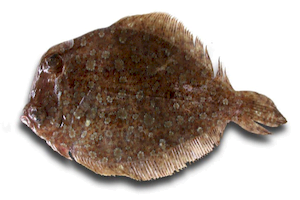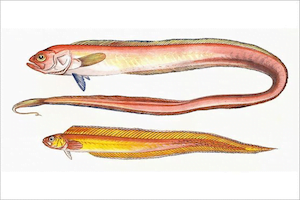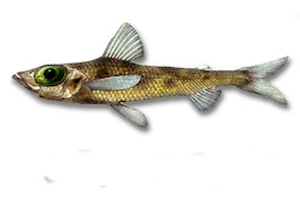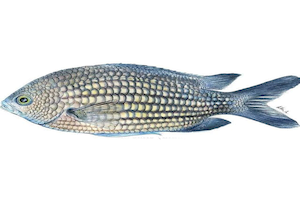Mugil Cephalus
– Flathead Grey Mullet –
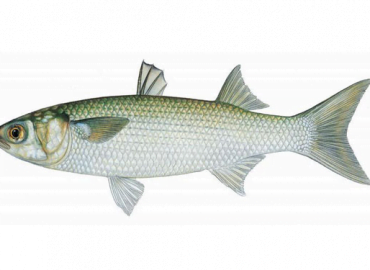

| Conservation status |
|---|
 Least Concern (IUCN 3.1)[1] |
| Scientific classification |
Mugil cephalus Linnaeus, 1758
| Kingdom: | Animalia |
| Phylum: | Chordata |
| Class: | Actinopterygii |
| Order: | Mugiliformes |
| Family: | Mugilidae |
| Genus: | Mugil |
| Species: | M. cephalus |

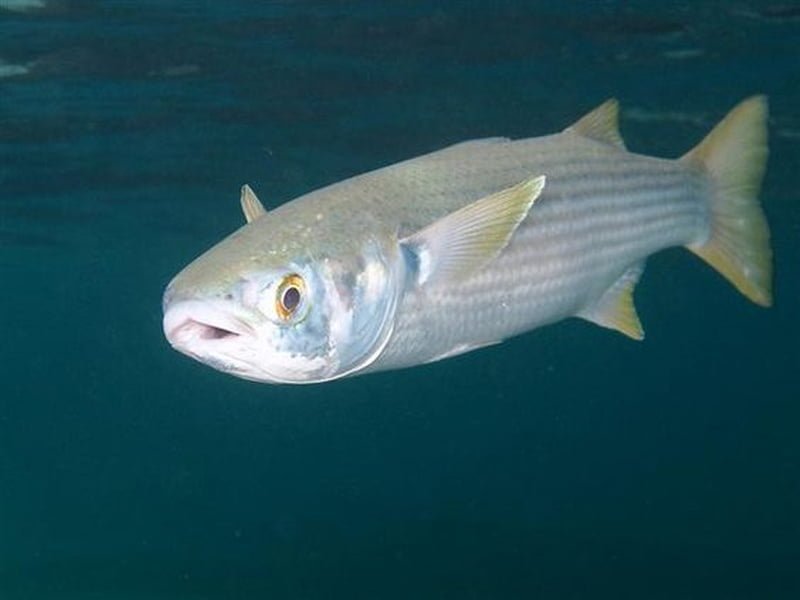
The flathead grey mullet[2] (Mugil cephalus) is an important food fish species in the mullet family Mugilidae. It is found in coastal tropical and subtropical waters worldwide.[2] Its length is typically 30 to 75 centimetres (12 to 30 in). It is known with numerous English names, including the flathead mullet, striped mullet (US, American Fisheries Society name), black mullet, bully mullet, common mullet, grey mullet, sea mullet and mullet, among others.[1][3]
The flathead grey mullet is a mainly diurnal coastal species that often enters estuaries and rivers. It usually schools over sand or mud bottoms, feeding on zooplankton. The adult fish normally feed on algae in fresh water. The species is euryhaline, meaning that the fish can acclimate to different levels of salinity.[4]
Description
The bighead mullet has an elongated body of about 35-50 cm , or even 70 cm, oval in section and robust in appearance.
The back of the fish is olive-green, sides are silvery and shade to white towards the belly.[2] The fish may have six to seven distinctive lateral horizontal stripes. Lips are thin.[2] The mullet has no lateral line. A common length is about 50 centimetres (20 in), and its maximum length is 100 centimetres (39 in).[2] It can reach a maximum weight of eight kilograms (18 lb).[4]
Its color is generally silvery gray , bluish (sometimes more or less white, olive or brown), becoming lighter on the flanks and the pale belly. Sometimes gray longitudinal lines and golden reflections are present on the dorsal part. The lateral line * is rarely visible. A small black spot is often present in the armpit of the pecs.
The flattened head is broad, adipose * eyelids are well developed (but not always clearly visible under water, because of their transparency) and protect the eyes close to the muzzle. Its mouth has straight, dense and fine teeth, usually in several rows. The commissure ends below the posterior level of the nostril. Her upper lip is thin and smooth .
It has two dorsal fins : the first with four spines and the second with 8-9 soft rays. The anal fin, yellowish, has 8 soft rays and 3 spines; the pectoral fins have 16-19 rays; the axillary * pectoral scale is well developed and is about a third of the length of the fin.
The ventral fins, anal and the lower lobe of the caudal are sometimes yellow (but not necessarily).
The scales, arranged in lateral series (36-45), are cycloid * (smooth).
Biotope
The flathead mullet is cosmopolitan in coastal waters of the tropical, subtropical and temperate zones of all seas,[2] as far north as the Bay of Biscay and Nova Scotia in the Atlantic Ocean.[1] It occupies fresh, brackish and marine habitats in depths ranging between 0–120 metres (0–394 ft) and with temperatures between 8–24 °C (46–75 °F).[4]The gray mullet lives in fresh water (rivers and estuaries) after being born at Sea (salinity 0-790 0 / 00 ).
In the Mediterranean, the fathead mullet enter coastal ponds and lagoons at the end of autumn to leave to reproduce at sea at the beginning of summer. It is at this time that it is fished for its eggs (bottarga), mainly in Martigues (13) and in Sardinia (Italy) but other small local farms exist, as towards Bastia (Corsica).
It is interesting to note that other mules, the sloth mullet and the pig-mullet, do the opposite, returning to the ponds in the spring and leaving them at the beginning of winter.
Similar Species
There are, on the French European coasts, mainly five other species of mullets or mules:
- The golden mullet (Chelon auratus ), with a thin upper lip, shows a very distinct golden opercular * spot. No black spot at the base of the long pointed pecs.
- Mullet-pork (Chelon ramada ) is characterized by its small scales and it has a black spot at the base of the pecs. Thin upper lip.
- The jumping mullet ( Chelon saliens ), whose upper lip is very thin, has a more slender body than that of other mullet and often has golden spots on the operculum. No black spot at the base of the long pointed pecs.
- The Sloth Mullet ( Chelon labrosus ) shows a thicker upper lip than M. cephalus , with small serrations on the lower edge. Sometimes a diffuse opercular spot of golden yellow color and a dark spot in the armpit of the pectoral muscles are visible. The fins are generally dark gray. Seen from above, the head of C. labrosus is more pointed than in M. cephalus .
- The labeon mullet (Oedalechilus labeo ), mainly southern Mediterranean, is recognizable by its very thick, smooth and raised upper lip. Her belly is a little swollen, hence the “stocky” appearance.
Other species, for example, frequent the eastern Mediterranean, such as the wandering mullet Liza carinata or the red-lipped mullet Planiliza haematocheila …
In the Caribbean, frequented by M. cephalus , there may also be confusion with the white mullet (Mugil curema ). But the white mullet is distinguished by its scales that extend over the dorsal and anal fins. The white mullet has 9 anal fin rays while the bighead mullet has 8 in adults.
The black mullet Mugil capurii is a species from the tropical Atlantic which closely resembles M. cephalus but its head is narrower and the forehead less arched.
Confusion is still possible with the wolf (or bar) ( Dicentrarchus labrax ) but the shape of the body as well as the shape and position of the mouth are very different. Another practical criterion of distinction: in D. labrax, the pectoral fin is below the tip of the gill operculum while in the mule, it is above.
Alimentation
Bighead mullet are day-feeding fish.
The juveniles feed on zooplankton * (micro-crustaceans, copepods, mosquito larvae, and plant debris for larvae that have arrived in fresh water).
Then larger individuals will consume microalgae, organic detritus and small invertebrates found on the bottom or on algae and seagrass beds.
Groups of fish are often observed taking bites of sediment on the bottom, appearing to graze on the sand.
Their long gastrointestinal tract and a stomach portion resembling a gizzard allow them to filter and digest organic detritus among the sediment.
Mules can also suck up the bio-films of algae that develop on the surface and in the scum.
Reproduction
Gonochoric * species, there is no visible sexual dimorphism *. Reproduction usually takes place from July to October.
The mullet Mugil cephalus which reach sexual maturity at 3-4 years away from congregate in large bench coast to spawn. Females can lay 0.5 to 2.6 million pale yellow, slightly floating eggs (0.72 mm).
The larvae * (2.4 mm) hatch 48 hours after fertilization and will drift in the plankton towards the coasts and estuaries.
Various Biology
While the size of the adult animal is commonly around 40 to 60 cm, the literature estimates that individuals could reach 120 cm for a weight of 8 kg.
Adults grow rapidly with a rate of 3.8 – 6.4 cm per year with a larger size for females.
Mugil cephalus provides an important ecological cleaning service by removing organic debris from sandy bottoms or seagrass beds. It is also an important link between the coastal ecosystem and the estuary by participating in the flow of matter between these environments.
A 16-year-old individual holds the record for observed longevity.
Further Information
These diurnal, school-dwelling fish are easy to observe between 0 and 20 m near sandy or muddy bottoms grazing the sand. They don’t run away from divers.
The species is abundantly fished, it is the most common of the mules. The catches can be put into aquaculture.
Populations are stable in most ranges. The IUCN status is “Least Concern”.
The Mugilidae family, at the level of all the seas, is rich in 17 genera with around a hundred species. Fossil representatives have been identified since the Priabonian, a period which belongs to the Eocene and which dates back to -35 million years ago.
Fisheries and Aquaculture
The flathead grey mullet is an important food fish around the world, and it is both fished and farmed. The reported worldwide catches from fishing in 2012 were about 130,000 tonnes and aquaculture production was 142,000 tonnes.[7]
Cuisine
The roe of this mullet is salted, dried, and compressed to make a specialty food across the world, such as Greek avgotaraho, Taiwanese Wuyutsu, Korean eoran, Japanese karasumi, Italian bottarga, Turkish Haviar and Egyptian batarekh. In Egypt, the fish itself is salted, dried, and pickled to make fesikh.
On the coast of Northwest Florida and Alabama, this mullet, called the striped or black mullet, is often a specialty of seafood restaurants. Fried mullet is most popular, but smoked, baked, and canned mullet are also eaten. Local fishermen usually catch mullet in a castnet, though most use a land based seine net. Mullet is a delicacy in this area and is most often consumed in the home. Mullet are usually filleted, and the remaining frames used for fish stock, used in chowders and stews.[8] The mullet most commonly consumed in Florida however is the white mullet (Mugil curema), because its preference for cleaner water gives it a cleaner and less muddy taste.[9]










